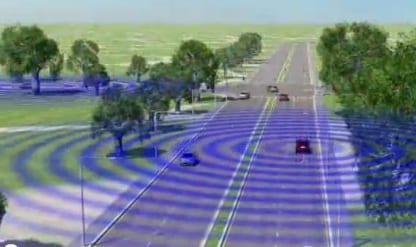 A yearlong test will outfit 3,000 cars, trucks, and buses with Wi-Fi “vehicle-to-vehicle,” or V2V, equipment, allowing them to “talk” to one another and transmit information about location, direction, and speed. The hope is that this technology, developed by U.S. Department of Transportation and Michigan’s Transportation Research Institute, could be the new standard for cars and reduce the severity of crashes. But for the field-service industry, it could be game changing.
A yearlong test will outfit 3,000 cars, trucks, and buses with Wi-Fi “vehicle-to-vehicle,” or V2V, equipment, allowing them to “talk” to one another and transmit information about location, direction, and speed. The hope is that this technology, developed by U.S. Department of Transportation and Michigan’s Transportation Research Institute, could be the new standard for cars and reduce the severity of crashes. But for the field-service industry, it could be game changing.
The V2V equipment “alerts” drivers to the guy barreling through a blind intersection, or the driver who’s stopping short at the upcoming light. According to statistics compiled by the DOT’s Bureau of Transportation Statistics, over a third of all occupational fatalities were transportation-related in 2009, the most recent year analyzed.
The DOT doesn’t track accidents by fleet compared to passenger, but for every 100 million miles driven by light trucks, there are 67 reported injuries. With advanced crash-avoidance technology, that number could drop even lower, test leaders say, or even reshape driving habits.
By connecting things like traffic lights, sensors on freeway entrances and off-ramps, and parking spaces to the Wi-Fi V2V network, transportation officials would be able to tap into the power of so-called “big data” to really analyze and optimize traffic patterns.
“Cars spend a lot of fuel idling,” says Mike Shulman, a technical leader for Ford, which, along with G.M., Honda, Nissan, and Toyota, is also involved in the test. “If they can communicate with the traffic lights, the light could tell the car that the light will be red for a specific amount of time and then the driver can turn off the engine and save fuel. People spend a lot of time looking for parking spaces. If you told the system where you’re going, the system could reserve a parking spot for you. All that stuff is possible once you connect up the whole network.”
The test will run for another year, so we’re not likely to see this sort of V2V utopia for a while yet. But it’s not hard to imagine fleet managers being among the first to adopt this sort of technology to study their own drivers’ patterns, and hopefully cut down on costly (and potentially deadly) accidents.
More: 4 Reasons Fleet Managers Might Switch to the New Ford Transit.

Share this: